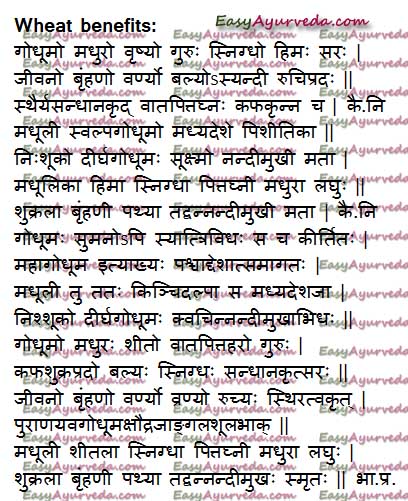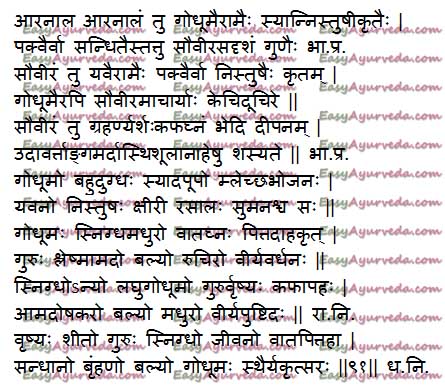Wheat Uses, Health Benefits, Side Effects: Complete Ayurveda Details
Wheat is explained many centuries before in Ayurveda text books as one among grains. It is used in the treatment of of gout, aphrodisiac therapy etc. As a dietary ingredient, it is hailed to improve body strength and nourishment. It is also used in Ayurvedic procedures related to Panchakarma and Upakarma (sub therapies).
Latin name – Triticum aestivum
Family – Poaceae
Table of Contents
Medicinal properties
Medicinal properties of wheat –
Rasa (Taste) – Madhura (Sweet)
Guna (Qualities) – Guru (Heavy for digestion), Snigdha (Slimy in nature)
Vipaka – Madhura (Undergoes sweet taste after digestion)
Veerya (Potency) – Sheeta (Cold)
Karma (Actions) – Vatapitta shamaka (Balances Vata and Pitta Dosha)
Read related: Wheat – Barley Chapati And Roti: Health Benefits, How To Make?
Part used, dosage
Part used – Grain
Dosage: Powder of the grain – 50 – 100 g
Varieties
Three types of wheat are explained –
Maha Godhuma – bigger in size, imported from the west
Madhuli, Madhulika – smaller variety
Nisshuka / Nandimukhi – elongated, with blunt ends.
Read related: Ayurvedic Wheat Flour Ladoo With Jaggery: Preparation, Benefits
Uses of wheat
- Wheat is used as food grain all over the world; hence wheat powder is used to prepare bread and its various types as a staple food.
- Wheat powder is used to prepare ‘upanaha sweda’, a type of poultice where wheat powder is mixed with other pain reliving herbs which are used to treat condition of arthritis, inflammation and localized pain.
- Wheat powder is mixed with other aphrodisiac herbs like kapikacchu, aswagandha, milk etc. and made into a paste and consumed regularly.
- In Vatarakta (gout), the ointment made of ghee, the powder of wheat and goat’s milk is prescribed for external application.
- To improve the milk quality and quantity in lactating women, wheat powder along with rice powder and barley powder is mixed with cow milk and consumed as a regular diet.
- Wheat powder along with tree turmeric, manjishta, lodhra powder is sprinkled over fresh wound to control bleeding.
Sanskrit verse

Ayurvedic benefits, qualities
Wheat benefits and qualities as per Ayurveda:
Madhura – sweet
Vrushya – aphrodisiac, improves vigor
Guru – heavy to digest
Snigdha – unctuous, oily
Hima – coolant
Sara – induces mobility, causes diarrhea, purgation, relieves constipation
Jeevana – enlivening
Brimhana – improves weight
Varnya – Improves skin tone and complexion
Balya – improves strength and immunity
Ruchiprada – improves taste
Sthairyakrut – improves stability, strength
Sandhana Krut – heals fractured bones and wounds
Balances Vata and Pitta Dosha. Does Not improve Kapha Dosha to a large extent.

Madhuli and Nandimukhi
Madhuli – minor, smaller variety of wheat –
Hima – coolant
Snigdha – unctuous, oily
Pittaghna – balances Pitta
Madhura – sweet
Laghu – light to digest
Shukrala – improves sperm and semen quantity and quality
Brumhana – nourishing, nutritious
Pathya – good for daily consumption.
Nandimukhi variety of wheat is also of similar qualities. It has blunt ends and it is elongated.
Aranala
Wheat beer / Fermented preparation of dehusked and cooked wheet – Aranala
Kaphaghna – Balances Kapha Dosha
Bhedi – purgative
Deepana – improves digestion strength
Indicated in
Grahani – IBS, sprue, altering diarrhea and constipation
Arsha – haemorrhoids
Udavarta – bloating
Angamarda – Malaise, bodyache
Anaha – bloating, fullness
Asthishoola – arthritis, bone pain
Adverse effect
People having gluten allergy/ incompatibility to gluten should resist intake of wheat and other food items prepared from wheat as it can cause diarrhea, bloating and increased intestinal movements.
Reasons for increased gluten allergy:
Spraying of glyphosate before harvest has shown to have some effect on our microbiome (1). It is a herbicide, which kills the wheat crop 1 – 2 weeks before the time of harvest, so that the wheat properly dries up, leading to early harvesting of wheat.
Read related: WheatGrass Powder And Juice: Uses, Dose, Research
Wheat bread – made in old fashion way, where the wheat flour, water and yeast are left together for 10-12 hours overnight, helps to decrease the load of gluten in wheat, which helps in lesser gluten, which the body can process.
But when the fermentation is accelerated to just 1 – 2 hours, we come across higher amounts of gluten leftover in the wheat that could be causing the issue of gluten intolerance. There is only limited amounts of gluten that the body can process. Rest of the leftover gluten in the system causes the allergy.
Interaction with medicines, supplements
Can this be used while taking Homeopathic medicine?
Yes. This product does not react with homeopathic medicine.
Can
this medicine be continued while taking supplements like multivitamin tablets,
Omega 3 fatty acids etc?
Yes. Generally, this product goes well with most
of the dietary supplements. However, if you are taking more than one product
per day, please consult your doctor for an opinion.
With western
medicines
Seek your
doctor’s advice if you are taking this product along with other western
(allopathic / modern) medicines. Some Ayurvedic herbs can interact with modern
medicine.
If both Ayurvedic and allopathic medicines are advised together, then it is
best to take Allopathic medicine first, wait for 30 minutes and then take the
Ayurvedic medicine.
Systemic classification
Bhavaprakasha – Dhanya varga
Kaiyyadeva Nighantu – Dhanya varga
Raja Nighantu – Shalyadi varga
Scientific classification
Kingdom: Plantae
Order: Poales
Family: Poaceae
Subfamily: Pooideae
Tribe: Triticeae
Genus: Triticum L.
Vernacular names
Names in different languages:
Sanskrit name – Godhuma, Hindi name – Gehun
English name – Wheat
Kannada name – Godhi
Malayalam name – Godhambu
Tamil name – Godumai
Telugu name – Godhumalu
In Northern India wheat is called as Gehun in many languages.
Sanskrit Synonyms
Bahudugdha – It contains good amount of starch giving white color like milk
Arupa – grows in marshy land
Sumana – improves mental strength, calming
Mleccha Bhojana – used by westerners in meals
Yavaka, Hudumba, Girija, Satinama, Rasika
Chemical composition
Wheat germ oil is rich in tocopherol (vitamin E) content, total tocopherols 1897 mcg/g, alpha tocopherol 62%. The presence of ergosterol (provitamin D) has also been reported.
Wheat germ is also used for its minerals, proteins and lipid contents. Germ proteins are rich in lysine and possess high biological value and protein efficiency ratio. Wheat germ contains haemagglutinating and antipyretic factors, butthese are destroyed by toasting. It also contains haemo-proteins, possessing per – oxidase activity. Bran oil contains tocopherols, but major part of them (68%) is in epsilon form; alpha – tocopherol forms only11% of the total. Gluten lipids, associated with gluten, contain a high percentage of linoleic acid; lowering of serum cholesterol level has been observed in experiments.
Morphology, habitat
Morphology of Triticum aestivum:
Wheat is an annual grass with simple culms, erect, hollow or pithy, up to 1.2 m tall. Leaves are flat, narrow, 20–38 cm long, about 1.3 cm broad. Flower – spikes are long, slender, dorsally compressed, somewhat flattened. Rachis is tough, not separating from spikelet at maturity. Spikelets are 2–5 – flowered, relatively far apart on stem, slightly overlapping, nearly erect, pressed close to rachis. Glumes are keeled in upper half, firm, glabrous, shorter than the lemmas.
Habitat: Wheat is cultivated throughout the plains of Northern states. More than 100 varieties of wheat have been developed all over the world.
Author: Dr.BK Prashanth M.D (Ayu), Ph.D
E mail: [email protected]
Click to consult Dr Prashanth BK











7 comments
Gopi
Hello sir
As you mentioned ‘gluten’. Is this term coined in ayurveda? Or this allergy only from modern age?
Also can you explain about something about gluten allergy. From which type of wheat gluten is present? Is there wheat available in market today (gluten free one)?
Op
Surprised you are promoting Wheat which is well known to be Genetically Modified and the cause of many digestive diseases. Wheat, corn, soy are GMOs, not just n the U.S. but all over the world where Monsanto controls the bulk of food supply. Also isn’t wheat grass (in green juice) different from the wheat used in baking?
Dr J V Hebbar MD(Ayu)Author
I mentioned the benefits of wheat which is naturally, organically grown. Wheat grass is the grass of wheat
Gurdip Singh
Will You please provide me the reference of wheat in ayurveda book? along with page number and edition
Dr J V Hebbar MD(Ayu)Author
These are the references
Bhavaprakasha – Dhanya varga
Kaiyyadeva Nighantu – Dhanya varga
Raja Nighantu – Shalyadi varga
Jayanth G
Hi Sir,
Is there any reference about Jave godhi also known as Long wheat/emmer wheat/khapli wheat. If yes please quote the benefits as per texts.
Thanks much
Dr J V Hebbar MD(Ayu)Author
Please read here
https://www.easyayurveda.com/2019/10/12/barley-hordeum-vulgare/